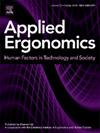Understanding older adults’ needs for and perceptions of shared autonomous vehicle interior features: A focus group and user enactment study
IF 3.1
2区 工程技术
Q2 ENGINEERING, INDUSTRIAL
引用次数: 0
Abstract
Shared autonomous vehicles (SAVs) can help older adults maintain mobility and independence throughout the later stages of life. However, research is critically needed to assess the design of SAV interior features and quantify potential mobility challenges for older populations. This paper presents a study that adopted a mixed-methods approach to evaluate the needs and perceptions of adults aged 65 years and older regarding interior features of SAVs during user enactment, and offers data-driven insights on task performance to inform design decisions. Thirty participants interacted with an SAV mock-up and participated in subsequent focus group discussions regarding their interaction experiences and general perceptions of SAV. Quantitative video-based time-motion analysis and qualitative thematic analysis of the focus group discussion highlighted concerns related to a) ingress and egress accessibility; b) seat and cabin comfort; c) appropriate social interactions with co-riders; and d) SAV operational functionality. Staggered seating arrangements and multi-functional use of available space were preferred features. The analysis also identified potential improvements, such as the inclusion of additional handholds and efficient HVAC systems, and underscored the need for central monitoring for emergency interventions during SAV operations. Ultimately, findings from this research can provide valuable insights for researchers and engineers to design equitable transportation solutions tailored to a broad range of traveler abilities and needs.
了解老年人对共享自动驾驶汽车内部功能的需求和看法:焦点小组和用户行为研究。
共享自动驾驶汽车(SAV)可以帮助老年人在晚年生活中保持行动能力和独立性。然而,目前亟需开展研究,以评估共享自动驾驶汽车的内部功能设计,并量化老年人群可能面临的移动挑战。本文介绍了一项研究,该研究采用混合方法评估了 65 岁及以上成年人在用户体验过程中对 SAV 内部功能的需求和看法,并提供了有关任务执行情况的数据驱动见解,为设计决策提供参考。30 名参与者与模拟 SAV 进行了互动,并参加了随后的焦点小组讨论,了解他们的互动体验和对 SAV 的总体看法。基于视频的定量时间运动分析和焦点小组讨论的定性专题分析突出了以下方面的问题:a) 进出口的无障碍性;b) 座椅和车厢的舒适性;c) 与同乘者的适当社交互动;d) SAV 的操作功能。交错的座位安排和可用空间的多功能利用是首选功能。分析还确定了潜在的改进措施,如增加扶手和高效的暖通空调系统,并强调了在 SAV 运行期间进行紧急干预的中央监控的必要性。最终,这项研究的结果可以为研究人员和工程师提供有价值的见解,从而设计出适合各种能力和需求的公平交通解决方案。
本文章由计算机程序翻译,如有差异,请以英文原文为准。
求助全文
约1分钟内获得全文
求助全文
来源期刊

Applied Ergonomics
工程技术-工程:工业
CiteScore
7.50
自引率
9.40%
发文量
248
审稿时长
53 days
期刊介绍:
Applied Ergonomics is aimed at ergonomists and all those interested in applying ergonomics/human factors in the design, planning and management of technical and social systems at work or leisure. Readership is truly international with subscribers in over 50 countries. Professionals for whom Applied Ergonomics is of interest include: ergonomists, designers, industrial engineers, health and safety specialists, systems engineers, design engineers, organizational psychologists, occupational health specialists and human-computer interaction specialists.
 求助内容:
求助内容: 应助结果提醒方式:
应助结果提醒方式:


